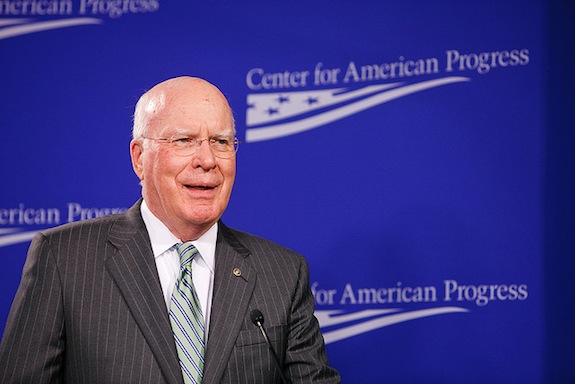
Sen. Patirck Leahy (pictured) and two congressmen have introduced legislation reinstating a new version of Section 4 of the Voting Rights Act. (Photo via the Center for American Progress)
By Ashley Lopez
Florida Center for Investigative Reporting
Following the U.S. Supreme Court decision striking down Section 4 of the Voting Rights Act, Congress is working to reinstate a similar provision that would require certain states to acquire federal “preclearance” for new voting laws. Unlike the provision enacted in 1965, though, Florida is no longer one of the state’s that would need oversight.
Last year, the Supreme Court ruled that the part of the Voting Rights Act (VRA) that required some states and counties to clear its laws with a federal court or the Department of Justice—which previously included five counties in Florida—was unconstitutional. According to the justices in that 5-4 ruling, that part of the law was based on old information.
Since then, voting rights advocates and U.S. Attorney General Eric Holder asked Congress to update the Voting Rights Act by creating a new list of states that would require federal preclearance.
Last week, Congress did just that.
Representatives Jim Sensenbrenner (R-WI) and John Conyers (D-MI) and Senator Patrick Leahy (D-VT) introduced legislation known as “The Voting Rights Amendment Act of 2014,” which would be the first attempt to reinstate a version of Section 4 of the VRA.
The legislation draws a new coverage formula for Section 4, thereby resurrecting Section 5. States with five violations of federal law to their voting changes over the past fifteen years will have to submit future election changes for federal approval. This new formula would currently apply to Georgia, Louisiana, Mississippi and Texas. Local jurisdictions would be covered if they commit three or more violations or have one violation and “persistent, extremely low minority turnout” over the past fifteen years.
The formula is based on a rolling calendar, updated with a current fifteen-year time period to exempt states who are no longer discriminating or add new ones who are, creating a deterrent against future voting rights violations. It’s based on empirical conditions and current data, not geography or a fixed time period—which voting rights advocates hope will satisfy Chief Justice John Roberts should the new legislation be enacted and reach the Supreme Court.
However, unlike the previous incarnation of Section 4, Florida is left out of federal preclearance requirements.
According to The News Service of Florida, voting rights advocates in Florida who have been battling the state on voting law changes in the past few years are disappointed.
“We’re very concerned on behalf of the voters of Florida and the groups we work with on the ground there,” said Katherine Culliton-González, director of voter protection for Advancement Project, a Washington, D.C.-based group involved in some of the legal fights in Florida.
One shortcoming of the preclearance formula, Culliton-González said, is that only a judge’s ruling or a denial of preclearance for a covered jurisdiction counts as a violation. If legal settlements or consent decrees were also included in the definition, she said, Florida would be eligible for coverage.
The new standard could actually encourage voting-rights groups and others to continue legal fights in hopes of getting a court order that would count toward preclearance, she said.
But advocates also note that the state would still be eligible for preclearance if there are problems in the future.
The Nation reports that one of the new bill’s strengths is that it makes it easier to submit a state to preclearance if there is trouble in the future.
According to the Nation, if passed, the bill would strengthen Section 3 of the VRA, which would make it easier to “bail in” states that are not required to submit to federal oversight. Right now it is very difficult to prove in court that a state or locality has taken part in intentional voting discrimination. This proposed law would make it easier. According to the article, “any violation of the VRA or federal voting rights law—whether intentional or not—can be grounds for a bail-in, which will make it far easier to cover new states.”
The bill also requires that all 50 states notify local media outlets 180 days ahead of a federal election if any election procedures related to redistricting were changed or if polling locations were moved.
According to the Nation, the legislation also “makes it easier to seek a preliminary injunction against a potentially discriminatory voting law…plaintiffs will now only have to show that the hardship to them outweighs the hardship to the state if a law is blocked in court pending a full trial.”
As of right now, voting rights groups in the state are keeping a close eye on Florida’s effort to remove non-citizens from its voter rolls. The state’s first non-citizen in 2012 was riddled with errors and eventually halted by local election officials in the state.
However, because the Supreme Court threw out Section 4 last year, the state was able to give it another try.
Also in 2012, the state experienced one of the most chaotic presidential elections partly because the GOP-led state legislature made sweeping and controversial changes to voting laws in 2011. Voting rights groups were able to successfully fight part of the law in court that made it harder for third party groups to register voters in Florida, but other parts of the law were not halted.
After a lot of media attention and historically long lines at the polls, though, state lawmakers had to reverse the voting rules they changed.
